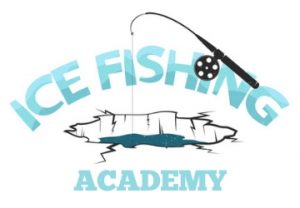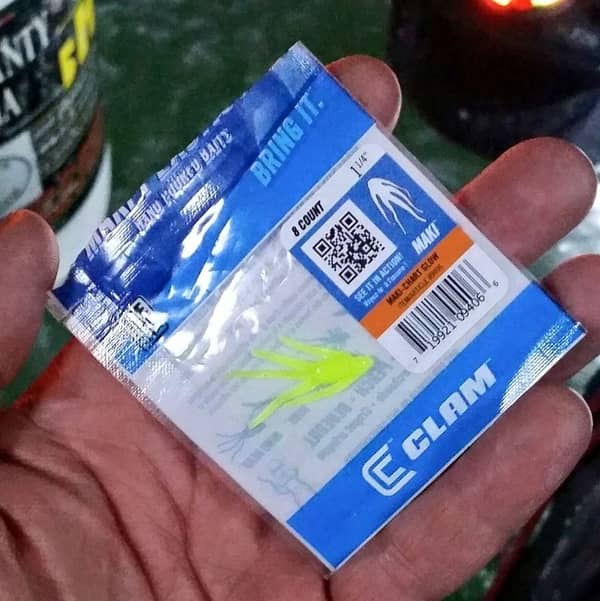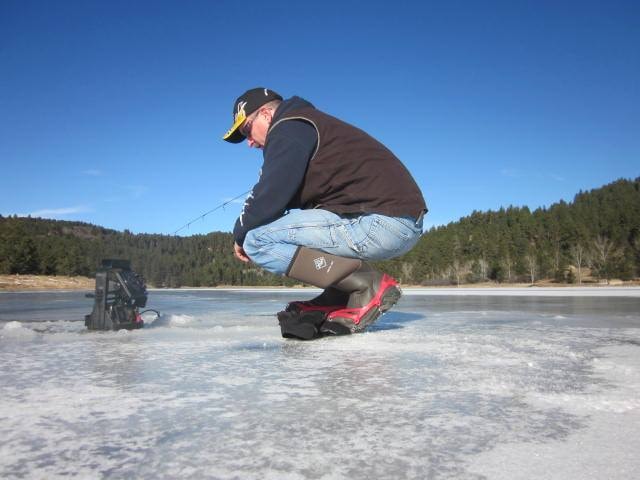It doesn’t matter if you’re starting to ice fish or a seasoned veteran of the ice. You need to bring along the basic essential gear required for a great day of ice fishing!
The essential gear needed for a day of ice fishing includes a rod and reel, lures such as spoons and jigs, live or plastic baits, tackle box, ice auger, skimmer, spud bar, safety ice picks, ice cleats or crampons, stool or bucket, pull sled, warm clothing, ice shelter, heater, and fishfinder.
I can carry a lot of gear on my ATV or snowmachine when going a long way out onto the ice for the day. But there are days when I walk out and only need to bring a bare minimum of gear to put fish fillets in the grease!
You might get by with less equipment, but I recommend starting with the basics of ice fishing equipment to have an enjoyable day. Here they are!
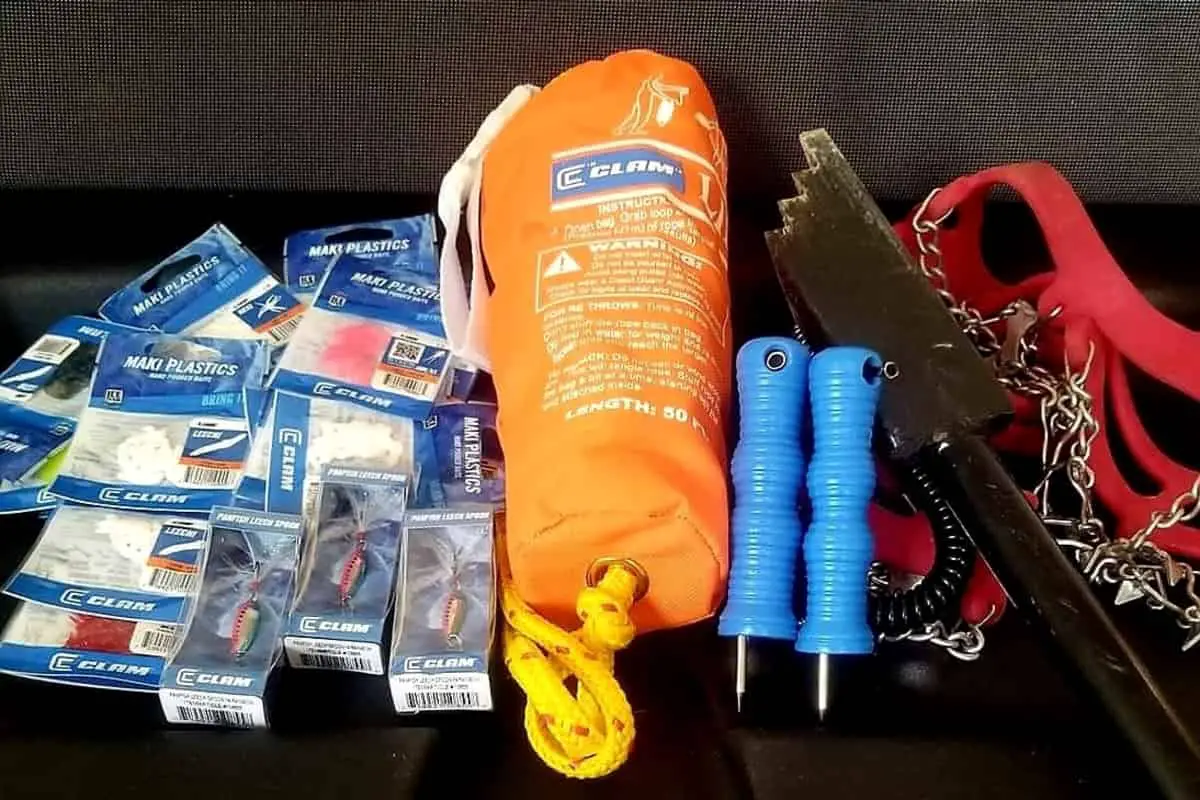
Jigging Ice Rod and Reel/Line
The primary equipment needed is a good quality ice fishing rod and a fishing reel with a smooth drag. Some fishing lines work and handle better than others in the cold, so a line designed for ice is recommended.
Ice Fishing Rod
You’ll want a good ice fishing rod matched up to your target fish. Since the most popular fish fishermen go after is the yellow perch, my choice of ice rod is a 24″ to 28″ light action spinning rod.
If you think you may hook into a larger walleye now and then, certainly step up to a medium-light or even a medium-action rod. Going with a longer rod, up to 36″ for larger fish, is preferred, but you give up the lighter action for perch and panfish.
When taking someone new to ice fishing out for the first time, they often ask if they can use their regular rods for ice fishing. Although you can, I do not recommend it.
Generally, longer regular rods are designed for accurate long-distance casting and have heavier rod diameters. Since there is no need for casting, ice fishing-specific rods are more sensitive and have lighter actions. They are also easier to hold while landing fish with your other hand.
Ice Fishing Reel
The most popular reel for ice fishing is, without a doubt, the spinning reel. When choosing a spinning reel for ice fishing, you want to keep in mind that having a smooth drag is essential.
A smooth drag allows a larger fish to pull the line off the reel without sudden starts and stops that could break your line. Generally speaking, the better reels have smoother drags and will cost more than a cheap reel.
Spinning reels also have ball bearings, considered an “anti-friction” bearing. Some reels will come with only one or two ball bearings, while higher-end reels may have up to 10 or 11+ bearings!
Ball bearings inside a reel will reduce friction and make the reel easier to use. Low-quality reels will have low-quality bearings and not perform like a higher-end reel with the same number of bearings.
In the past, I have used Pflueger President Reels almost exclusively. They are one of the most popular top-selling reels for ice fishermen and have ten bearings. From perch to monster walleye and lake trout, they perform great!
They are a great reel and have a long history on the ice. If interested, give the Pflueger President Series a quick, convenient look and price check on Amazon.
If you’re looking for a more economical ice fishing reel, Picscifun has been taking quite a share of the market, and I am seeing them more often on the ice.
With nine ball bearings and one roller bearing, you’ll be amazed at the pricing. Check out the Piscifun Flame Spinning Reel on Amazon.
Ice Fishing Line
Monofilament fishing lines have been popular for years and handle great during the warm summer. Mono lines will hold their memory and retain their coils during the winter and can cause many headaches.
Significant advances have been made with ice fishing lines and fishing lines. There are now a wide variety of quality ice fishing lines for you.
My choice for an all-around fishing line setup is to use a braided line and attach a 3′ to 4′ leader of a clear fluorocarbon line. With this setup, I can quickly change leaders to target different species and keep the same braided line on the reel.
- I’ve written an article on different fishing lines and when to use them, Fishing Line: Ice vs. Regular: What’s the Difference?. Check it out for additional line info!
Tackle and Lures – Spoons and Jigs
It’s often been said fishing lure companies develop new baits and lures to catch fishermen rather than catch the fish! There’s probably a lot of truth to that statement!
You can go all out and spend a ton of money on new-fangled lures with holographic designs and “mean-looking eyeballs” painted on them. There are even individuals who custom-paint hardbody lures!
But the standard spoons and jigs are tough to beat for the money and the person looking to get onto the ice for the first few times!
When I gear up to fish early ice, I don’t take along a lot of gear, basically my safety gear and a handful of jigs and spoons. You don’t need large tackle boxes full of multi-colored baits in eight different sizes!
My go-to lures are relatively simple and catch a wide variety of fish for me, including trout, perch, crappie, bass, and the occasional pike.
Spoons – You’ll Only Need a Few
Spoons are excellent lures for a variety of popular fish. Ice fishing spoons are tied to your line at one end and have a treble or a single hook hanging below the lure. They are fished vertically, sink quickly, and mimic a dying minnow bait when raised and dropped back down.
For killer spoons, I carry about six to eight Leech Flutter Spoons in a small pocket tackle box. They are designed by people who ice fish for a living, have the best-looking action in the water, and come in a kit package.
The confidence spoon I like to start with is the Gold one. The rainbow trout pattern works well in my area of Wyoming, and I’ve fished these spoons in Idaho, Montana, South Dakota, and Canada! They work everywhere.
Since most people will fish for perch, crappie, and trout, I’d recommend the 1/8 oz size as a basic size.
Take a quick look at the wide variety of sizes and colors for these fish-catching Leech Flutter Spoons on Amazon. At least carry a few with you!
Jigs – The Foundation of Ice Fishing
Ice fishing jigs are lures fished with a horizontal presentation and come in many colors, and can have bodies made of plastic, chenille, or hard body materials. Jigs can have a lead or tungsten head with an exposed bare hook. You can tip the plain hook with a minnow, maggot/spike, or plastic body.
Jigs generally represent different types of baitfish and come in many shapes and sizes.
One jigging bait found in almost all ice fishermen’s tackle boxes is the Rapala Jigging Rap. The jigging rap has the eye to attach the line right in the top center of the body.
It’s pretty heavy for its size and falls rapidly through the water column.
This type of jig has been a mainstay for ice fishermen for decades and can be found far back in fishing history!
When starting your ice fishing journey for the first few trips, you’ll want to have a handful of jigs to get you started. The following two jigs are my favorites and “go-to’s” when on a new lake or the fishing gets tough!
The gold Drop Jig is a tough one to beat for an all-around jig! Jigs can be tipped with either live baits or soft plastic baits, and fishes hard and heavy.
When the perch are holding close to the bottom, and you need to get your bait back down quickly, not much else will match its drop speed.
The same holds with schools of crappie that are either suspended halfway down the water column below you or schools that are moving through the area you are fishing.
With a few Drop Jigs and a pocketful of soft plastic baits in various colors, I can thoroughly fish a body of water with a wide presentation.
In addition, the jig’s weight allows you to use different jigging styles and pound the bottom to raise sediment and imitate a feeding fish.
When looking for a lighter, more finesse presentation, the one-two punch of the Drop Jig above and the Caviar jig below is a formidable pair to beat!
The Caviar jig looks like fish eggs, and it slowly floats down through the water column. Finicky fish cannot resist it. Especially when tipped with a sensitive soft plastic bait.
Although my fishing style is a bit more aggressive, and I tend to look for actively feeding fish, when the bite is light, a slow presentation of falling eggs is a tough combination for a fish to turn away from.
You can find my number one jigging tactic in my article 11 Steps: How to Jig When Ice Fishing to Catch More Fish!
Live Bait – Spikes, Maggots, Minnows
Live baits are a staple of the ice fishermen, especially when fishing for bluegills, perch, trout, and crappie!
Spikes
Spikes are larvae from blowflies, and you have most likely seen them in a garbage can or on roadkill.
Since they are typically the smaller baits, they are used for smaller fish with smaller mouths, like bluegills and sunfish. Trout can be fond of them as well!
Local bait shops typically carry spikes during the ice fishing season, but if you don’t have a bait shop close by, check gas stations near the lake or even a pet store!
You can lightly hook a spike through the tip or pack several of them on the hook. It all depends on how the fish are biting and feeding!
Maggots
Maggots are the larvae from house flies. A little larger than the spikes above, they’re typically about a half-inch long with two black eyes.
You can locate maggots at bait shops, gas stations, and pet stores. Pet stores will have maggots and spikes on hand to feed to lizards and other reptiles!
Minnows
There are quite a few species of minnows fishermen use in different areas, from chubs to shiners and fathead minnows to various dace minnows.
Minnows may be fished in many ways.
- Hooked through the mouth
- Hooked through the eyes
- Hooked behind the dorsal fin
- Hooked near the tail
- Head or tail pinched off and tipped on the hook
Keep in mind some species of minnows may be allowed as bait in one part of the country while not being allowed in another!
Invasive species are a hot topic right now. And in the Rocky Mountain Regions of Colorado, Idaho, Montana, and Wyoming, introducing a particular minnow into a specific drainage area can have drastic consequences for the fishery.
Many states allow the use of commercially produced live baitfish throughout their region. What are commercially produced or “State Approved” minnows?
Commercially Produced Live Baitfish
Means adult fathead minnows that were propagated and reared in a Department approved private fish hatchery.
Wyoming Game and Fish Dept
Check your local fishing regulations to ensure you aren’t violating minnow restrictions before heading out to the ice with a bucket full of minnows.
There are also waters where you can only use artificial baits, and no live baits are allowed! Better safe than sorry and incurring a hefty fine or violation!
Soft Plastic Baits
After my minnow bucket was dumped in my ice sled a few times, I started fishing with plastic baits! Handling wet minnows in cold temps wasn’t fun either.
Storing leftover minnows can be a chore if you’re not going back out on the ice in the next day or so.
Today, soft plastic baits are my mainstay as they have become much more advanced and lifelike.
It’s easy to put a dozen packs of soft plastics in your coat pocket and be good for the day. With the many colors and types of plastics, it’s the rare occasion you’ll come home empty-handed!
My favorite soft plastic is the chartreuse Maki for its versatility and the numerous ways these plastics can modify it for aggressive or light-bite finesse presentation days!
The best things about using scented plastics like Makiplastic are their convenience and ease. There is no need to carry minnow buckets with water, oxygen needs, cold, wet hands, dying minnows, or a need to store them.
Plastics are an essential item today for modern on-the-move ice fishermen!
Tackle Box – Storage for Baits and Terminal Tackle
You will have terminal tackle in any fishing, such as snap swivels, split shot weights, hooks, spoons, and jigs. Other assorted items like line cutters and hook removers are needed too.
You’ll need a place to store and carry them, and you’ll find an assortment of tackle storage systems.
I’m a big fan of soft folders for plastics and either Plano boxes or small jig & spoon pocket storage boxes.
Plano Guide Series Tackle Storage for Soft Plastics
Small to medium storage containers will fit into most coat pockets and are readily accessible when needed.
Ice Auger and Ice Skimmer
An ice auger is needed to drill a hole through the ice. Then an ice skimmer removes the ice chips and slush, which will be left behind from drilling.
Most people will purchase a hand auger when ice fishing for the first time instead of expensive gas, propane, or electric auger.
Don’t skimp and go with a generic brand when choosing an ice auger. Often you will find they don’t handle or cut ice as well.
In addition, with some lesser-known brands, if you chip a cutting edge on your blade or become dull, they are often difficult and time-consuming to sharpen or replace.
A hand ice auger with a well-known reputation and cutting ability is the StrikeMaster Lazer Hand Auger on Amazon.
The Lazer is a fast-cutting auger, and the blades will remain sharp for a very long time. The quickest way to ruin a day on the ice is to drill multiple holes with a dull auger.
As technology improves, electric ice augers are being used all over the ice belt! When ice fishing in Canada, a few of my buddies use electric drills to cut through 56 “+ of ice!
I own and use a small Lazer Hand Auger, a gas-powered StrikeMaster 8″ auger, and a K Drill Ice Auger I power with a Milwaukee M18 Fuel Drill.
Ice Fishing Spud Bar
An ice fishing spud bar is often a new concept to those just beginning their ice fishing adventures. It can accomplish two things for you!
- Check the safety and thickness of the ice as you walk out from shore over deeper water.
- You can use a spud bar to chisel a hole through the ice during the first ice season.
As you walk out from shore using the spud bar, a heavy length of steel with a sharpened chisel point, to stab at the ice every few steps or so.
A few solid thumps and the spud will tell you if the ice is thick enough to walk on. If it goes straight through the ice, you know to back off and head toward shore!
Once you reach a spot you want to fish, you can use the spud bar to chisel a small hole through the ice! Now you can leave your hand or power-auger at home when the ice is thick later in the season.
Safety Ice Picks
Safety ice picks are the PFD and seatbelts of the ice! You should always have them with you and wear them over your shoulders or around your neck.
Ice picks have steel points that you can dig into the ice to extract yourself back onto good ice if you fall through. The two handles are connected with a retractable coil, so they remain out of your way unless needed.
The Frabill Deluxe Retractable Ice Picks on Amazon is a terrific set.
No matter what time of the ice season it is, whether early ice, super thick ice in the middle of the season, or late ice, I always wear a set of ice safety picks! You should carry ice picks too!
Ice Cleats – Crampons
By far, the most uncontrolled I have ever felt is when my feet slip out from beneath me while walking on the ice! You go from being in total control to having absolutely none in a split second!
Over the years, I have worn numerous traction devices on my boots, most of which either broke or would fall off my footwear.
Having fallen several times and luckily not breaking or hurting anything, I finally bit the bullet and purchased my first, and so far only, pair of Khatoola MicroSpikes. I have had them for five seasons, and they are still going strong!
If there is at least a skiff of snow on the ice, you can get away without having them. The snow gives you the traction you need to move around safely.
When a slight snow drifts, and you have large bare spots of ice, ice cleats and traction devices come in handy! Stepping from the snow onto the ice with rubber-soled boots and you’ll often go flying!
An inexpensive pair is better than not having anything, and young don’t want to slip and fall and hurt an elbow or bang your head hard on the ice.
Stool, Chair, or Bucket
Having something to sit on can make or break your day on the ice!
I carry my gear in a five-gallon bucket when going out on early ice. Once I arrive at my fishing spot, I’ll use the bucket for sitting on.
If you keep a few fish for dinner, the bucket is a great way to return and transport your catch back to the house!
Three-legged camping stools are inexpensive and stored easily. You can bring a folding lawn chair or camping stool too. When I go out with a few new guys, I throw a couple of these into my pull sled.
Several companies also produce nice “ice fishing chairs” with rod holders and storage pockets. They fold up and are used as a backpack while you’re walking.
Ice Fishing Sled
We only have two hands, and although you can carry quite a bit of gear in a five-gallon bucket, it can become heavy to carry on one side of your body for very far.
This is where a small ice fishing sled you can pull with a rope comes in handy.
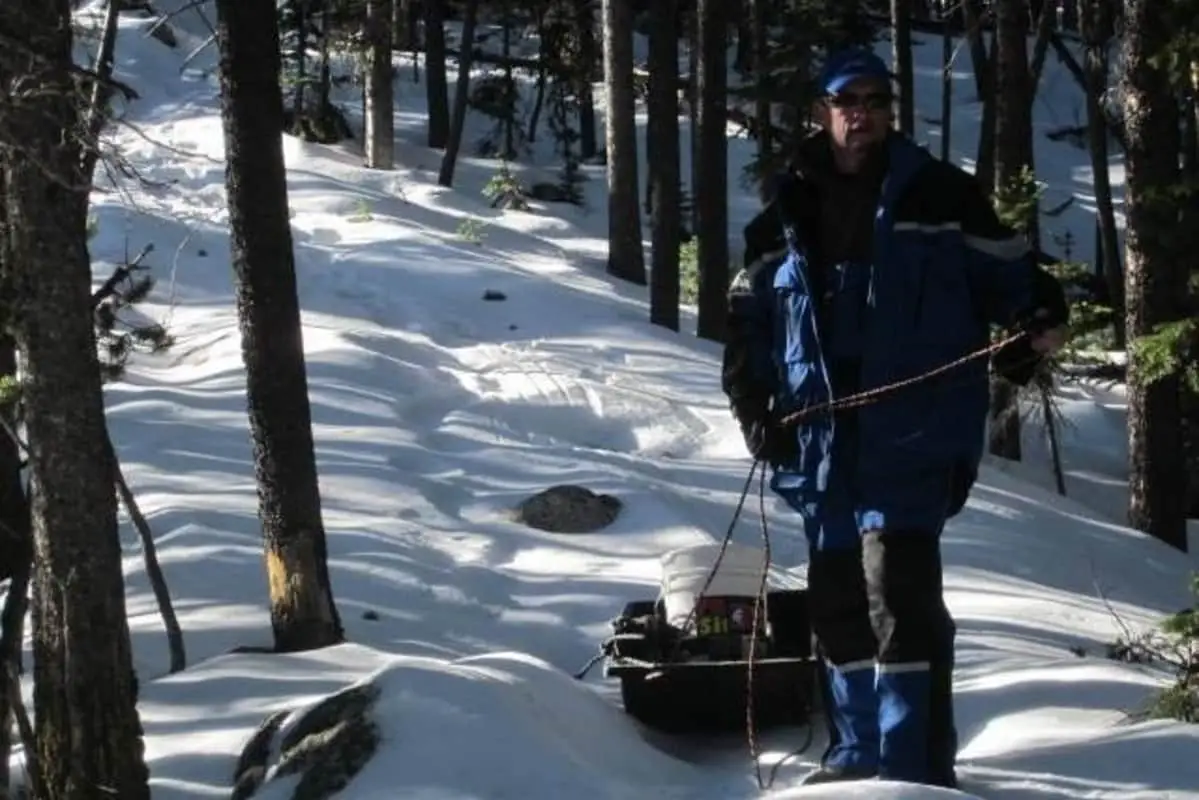
When fishing off the beaten path or hiking quite a ways, a sled can be your best friend! You can carry a bucketful of gear, your auger and spud bar, snacks, and drinks comfortably.
The first thing I do when using a sled is toss away the cheap short rope that comes with it. I replace the original rope with a 12′ length of larger diameter 3/8″ rope.
Replacing the rope with a longer section keeps the sled from banging up against the back of your feet! It’s a lot easier to shorten the rope by grabbing it further back when needed, and it’s also easier to pull with the longer rope.
When pulling a sled and going downhill, let it go ahead of you and hold it by the rope! Plus, you can lower your sled down a bank or ledge with the longer rope.
More information on sleds, sizes, and other things you might want to know about them can be found here: Do Ice Fishing Sleds Float? What You Need To Know!
Warm Clothing
Once you become cold, your day is going to be a tough one. Most people start heading home when they become cold. Warm outer clothing and layering your clothes are essential to having a good day on the ice.
I’ve fished in blue jeans and a heavy hoodie sweatshirt on nicer days. I’ve even ice fished in Carhartt clothing, and many people still do. It is warm stuff, but it lacks being wind and waterproof.
Carhartt has new winter clothing lines that claim to be water and windproof, and I’m sure it works on the job site, but they are not designed for being out in extreme weather for extended periods.
Cabela’s Guidewear is designed for extreme fishing conditions, as are some other major outdoor gear manufacturers’ clothing.
The Extreme Advantage Ice Parka and Bibs are what I wear. They are designed for ice fishing and have many options, including pockets and storage. The bibs also have full-length enclosures down the legs for easy on and off with boots.
Both the parka and bibs have removable insulated liners that make it easy to change the layering and warmth factors, whether it’s nice out or -10 below zero.
Having a wind and waterproof clothing system that keeps you toasty warm is like wearing your ice shelter, and although I bring a shelter with me a lot of the time, I’m rarely sitting inside it.
Ice Shelter
Speaking of ice shelters, it’s a rarity I climb inside of mine! I have owned a number of them for different reasons over the years.
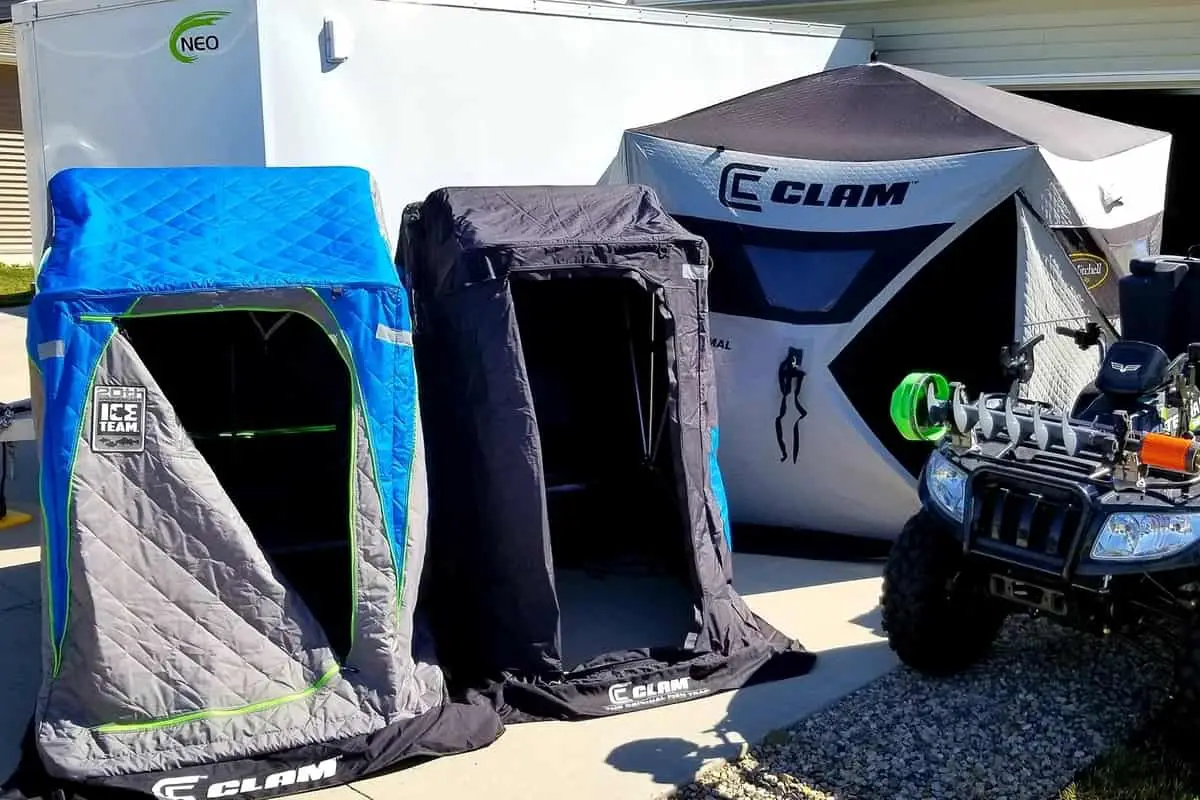
The one thing I enjoy about having a portable ice shelter is placing all my gear inside the tub and pulling it by hand.
When I travel, it is easy to place the whole shelter with gear into the bed of my pickup, and the tent/cover keeps any snow or debris from getting into my gear.
My gear is also covered from prying eyes when stopping at a convenience store for gas or something to eat.
Generally, if you’re adequately dressed during the day, you can remain outside and fish comfortably. But once the sun goes down, the temperatures can drastically drop.
During these hours after sunset, you will want to be able to sit inside a shelter to warm up and stay out of the wind.
Heater
If you have a portable ice shelter, I recommend a good propane heater to keep yourself and your buddies warm on those colder days!
Once your fingers become cold, it isn’t easy to warm them up adequately while on the ice. I’ve walked back to my vehicle to warm up my hands!
A small portable propane heater takes up very little room in your ice fishing sled or shelter tub, and two 1lb green propane bottles should keep you warm most of the day.
Several small portable heaters you can purchase do an excellent job. A heater with an auto-shut-off is crucial if it’s tipped over, the pilot light goes out, or the heater senses low oxygen levels.
Depending on which shelter I decide to use that day, I bring along one of the two propane heaters I use. For my one-person shelters, I bring along my Mr. Heater Buddy.
When fishing with a few friends or taking kids out to introduce them to ice fishing, the larger Mr. Buddy Is a blast furnace inside the Jason Mitchell 5000 insulated pop-up!
Electronics – Fish Finder
Last but certainly not least is a good fish finder or flasher.
You can catch many fish without a flasher/fish finder, but the game changes once you add electronics.
I have often said if I arrived at the ice and left my flasher on the counter at home, I’d drive right back to the house. They’re that important to me!
With a flasher, you can tell if there are fish below you. Knowing there are fish down there, especially at what depth, gives you an advantage in catching them!
The top three ice fishing flasher companies are Vexilar, Marcum, and Humminbird. You can almost spend as much as you want on a flasher, but you don’t need all the bells and whistles when first starting.
You can pick up a basic model like the Vexilar FL-8 or FL-18 or even a base model Marcum or Humminbird. They all do the job great!
Generally, during the late Summer or Fall, people will begin to sell their electronics and shelters on Facebook Marketplace, online classifieds, or many ice fishing forums as they upgrade their equipment.
That’s my list of essential ice fishing equipment you should strive to bring with you. Of course, you can bring along additional gear if you choose to.
But for the most part, except for bringing a shelter each time and a spud bar after the ice becomes super thick, the above is the gear you’ll almost always find with me!
Have fun and stay safe out there!
